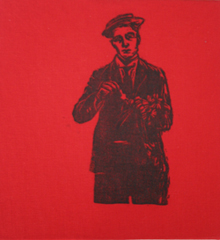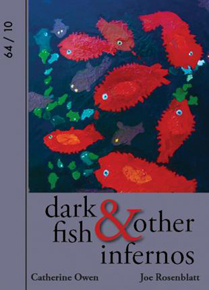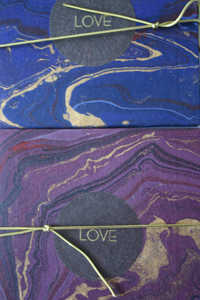Reviews
Poetry Reviews by Jay Ruzesky
Catherine Owen and Joe Rosenblatt, Dark Fish and Other Infernos. Illustrated by Joe Rosenblatt. Design by lisa m. johnson. (Saskatoon: JackPine, 2011). np., $30.
Onjana Yawnghwe, The Imaginary Lives of Buster Keaton. Designed by Shane Plante and Onjana Yawnghwe. (Saskatoon: JackPine, 2011). np., $30.
Patricia Young, Pilgrimage: Love Poems. Design and photographs by Dorothy Field. (Saskatoon: JackPine, 2011). np., $30.
It is 2010 and I’m on the ferry between Horseshoe Bay and Nanaimo heading to Vancouver Island. The forward lounge holds about 250 people and as I scan the room I see one person staring at a Kindle. There are about 100 other people reading books or newspapers and the rest are talking or trying to get some rest. Non-scientific survey puts print over e-books 100:1. Two years later on the same ferry in the same lounge, I look around and count iPads, PlayBooks, other tablets, phones, laptops, and netbooks. It looks like half of the passengers are using some type of electronic device although it is hard to say if they are reading or texting, watching movies, or playing games. There are people reading books, magazines, and newspapers, but print is now about even with electronic media, about 1:1. Once again, some people are trying to sleep. Dreams will never go out of fashion.
We are a long way from the death of books. They’re wounded
though, suffering. Most academic libraries no longer buy print books,
preferring instead to purchase licences for e-books that offer them
massed together by category. It is not a radical suggestion to say that
books will not go away completely. They are too beloved and, well,
they are solid technology themselves—portable, durable, transferable.
Read on the beach, in the bright sun, in the bath, etc. Others have
pointed this out. The books that will be the first to fade away are the
ones that are barely books anyway: mass-market paperbacks; cheap
editions on cheap paper sold in racks at the superstore. No one will
care when the only way to get them will be by downloading. Real
books though, the kind of books where the print feels tactile because it
has been stamped into the paper, books printed on forty-pound linen
paper stock, and deckle-edged books that we love to hold in our
hands, will stick around. That is why there is a niche for publishers like
JackPine Press in Saskatoon. They understand that the book itself is an
object and, as such, is a kind of art form that holds another art form
within. The stated mandate of the press is to facilitate “the creation of
hand-produced chapbook projects in limited editions of seventy-five
copies.” The final products are “literary and artistic book works that
demonstrate a unified collaboration of text and design.” No two editions
are the same.
The Imaginary Lives of Buster Keaton by Onjana Yawnghwe and
Shane Plante is an excellent example of what this press is doing right.
There is a front and back cover to the book but inside is movie magic.
A series of cards with images on one side and couplets on the other are
slipped into frosted envelopes to make the pages. The cards can be
removed and rearranged so the reader becomes the “editor” of the
sequence, deciding, for example, whether “most people have a devotion
to gravity / but we are all acrobats before we are born” should
come before or after “there is no yelling in silent movies.” The book
even sounds a little like a film projector if you flip through quickly. Dark Fish and Other Infernos is a chapbook wrapped in a fabric fishtail
and it tells a fabric fish tale that is part love story, part science fiction.
Catherine Owen and Joe Rosenblatt step into voices and personas
to investigate the edges of mystery where
excellent example of what this press is doing right.
There is a front and back cover to the book but inside is movie magic.
A series of cards with images on one side and couplets on the other are
slipped into frosted envelopes to make the pages. The cards can be
removed and rearranged so the reader becomes the “editor” of the
sequence, deciding, for example, whether “most people have a devotion
to gravity / but we are all acrobats before we are born” should
come before or after “there is no yelling in silent movies.” The book
even sounds a little like a film projector if you flip through quickly. Dark Fish and Other Infernos is a chapbook wrapped in a fabric fishtail
and it tells a fabric fish tale that is part love story, part science fiction.
Catherine Owen and Joe Rosenblatt step into voices and personas
to investigate the edges of mystery where

All that glitters is not food for fish.
The net of eternity catches them and us.
But what Fisher then is steering our boat
through the sexy nebulae and wafting mist?
(“Kirkby’s Sky”)
The book is illustrated with drawings by Rosenblatt sewn in like leaves of light. The book is not as conceptually tight as Buster Keaton, and is physically strange (I cannot figure out exactly how to lace the fish back together) but is fascinating for its weirdness.
The third book I have is Pilgrimage: Love Poems written by Patricia
Young and designed by Dorothy Field. It is constructed as an orihon
(accordion) and consists of nine prose poems beside nine photographs.
The writing in this book is powerful, and I like the subtle way
that, rather than trying to illustrate the events in the poems, the photos
seem to be engaged in conversation with them.

I picked up these books at the Victoria book launch for JackPine Press so I was lucky enough to get to see the performance side of these works as well, and to hear the creators talk about their projects.
—Jay Ruzesky









